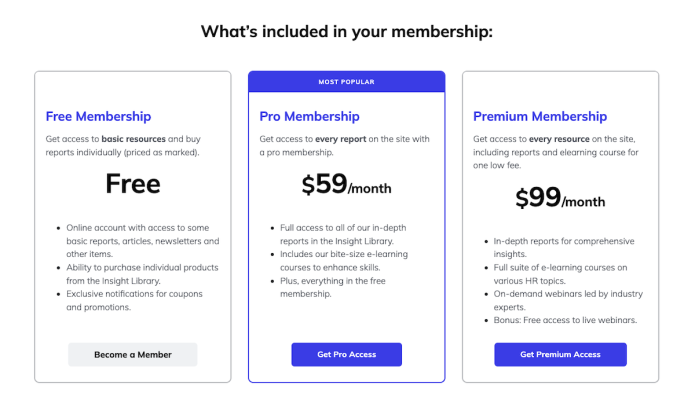
What is a membership portal?
A membership portal refers to member-only access to a website for exclusive access to content, services, and resources, generally reserved for paying subscribers. Free membership would also be part of the membership portal, but wouldn’t require payment. There will also be a part of the website that is directed to the public, containing sales information and links to a sign-up page. The membership portal refers strictly to the webpage members use to access their content.
Membership portals are used by organizations, clubs and businesses to share content. This can mean sharing expertise, coaching and training programs and time-sensitive announcements. The portal is a centralized location to access information, connect with other members, and participate in events.
What are the benefits of a membership portal?
For the business owner, a membership portal provides an automated way to offer paid content. For you as the administrator, the portal should contain everything you need to run your membership. That includes payment processing, a content management system, a member management system, and metrics that give you important information about the activity of your members.
For members, the portal is the “go-to” hub containing the content they signed up for. Content can be in the form of text articles, images, video, audio or embedded files such as PDF's. The portal is an exclusive, “member-only” area that can only be accessed via username and password. The most effective portals provide access to everything members need to take full advantage of their paid membership in one central location.
In this article, we will discuss the most important features of membership portal software, how to create a simple membership portal, and how to manage a membership portal effectively.
Creating a membership portal

It’s true that there are quite a few “moving parts” to a membership portal, but that doesn’t mean it has to be an arduous process. Wit the right tools, you can easily get a membership portal up and running with the basics in place in a few days. Following these fundamental steps should get you on your way to profitability quickly:
Define your goals
Before you can even think about setting things up on the software side, you need to create a business plan, or at least determine how you intent to generate income from your membership. What do you want to achieve with your portal? Who are your target users? What kind of content and features do you want to offer? And you want to answer these questions in a way that allows your goals to be specific, measurable, and achievable. Asking questions like this will be among your first steps:
a) Who is your audience? Yes, this is ‘Marketing 101’, and it applies here just as much as any other business endeavour. Be as specific as possible when determining the characteristics of your ideal member. Include age, gender, income, needs, desires, wants and likelihood to engage with your content.
b) How much revenue will you need to run your membership? You may not know the specifics of this upfront, but you estimate the costs of software, staff, equipment, as well as the cost of your time commitment per month. This will help you start shaping your portal idea in terms of how many memberships you’ll need to acquire over what period of time in order to make a profit.
c) How will you measure the goals you have set? Some parameters you can track include new memberships, membership retention (churn), member engagement, and course enrolment.
Consider content and features
You'll want to consider what types of resources, services, and benefits to offer your members, and how they will be delivered. Will you offer videos, audio files, articles, or downloads? Will there be any live coaching or content? Do you need a streaming service? Will you bundle membership subscriptions with other products such as courses or e-books? Be sure to be very clear from the outset what the specific benefits of membership are going to be. If people are expecting something they don’t get after they sign up, you could end up with more refund requests than you budgeted for.
Design your portal
Unless you are targeting a completely new audience, you’ll want to be sure that your design elements, logo, colors, fonts, etc. match those of any other branding materials you have created. If you already have a website that you will continue to use after the membership portal is up and running, consider naming the portal with a subdomain of the primary website. This helps to “extend” your brand to the member-only portal (and saves a bit of money on another custom domain.)
A few other tips to keep in mind when working on design and layout of your membership portal:
a) Ensure your design is user-friendly and mobile-friendly. Members need to be able to easily navigate from one area of the site to another to find the information they came for.
b) Provide clear instructions on exactly how to use the portal. You might have a “how to use your portal” page on your website where you provide step by step instructions with screenshots and links into the content.
c) Also include FAQ pages, support guides and tutorials to help users get them most out of their membership. In case those resources are not enough, always provide a way for members to contact you directly with questions.
d) Don’t forget to be mindful of online etiquette. Avoid gossip and any negative talk in communications or bulletins. You may also want to provide guidelines for your members in that regard as well.
Choose a membership portal platform
To run a successful membership portal, there are a few essential tools that you will need to consider. According to Nonprofit Pro, these tools include an online member community platform, a membership database, learning management software, virtual event software, a content management system, and marketing platforms.
Let's delve a little more deeply into the features to look for in a membership portal platform, and the SubHub platform in particular.
Some of the most important features of membership portal software include:
1. Membership Management: Here you can keep track of contact information, membership level, and payment history. You can also track membership renewals, send reminders, and process payments online. The SubHub platform is integrated with Stripe and Paypal for easy payment processing. Renewals are taken care of automatically, and if a member cancels, their subscription is automatically cancelled in Stripe and Paypal.
2. Content Management: Membership portals often include a content management system (CMS) that allows you to create and manage content, such as news articles, event listings, and member profiles. Members can access this content based on their membership level or other criteria. The SubHub platform, for example, offers a built-in member directory, member forum, and the ability to showcase upcoming event on homepages.
3. Communication Tools: Membership portals typically include a variety of communication tools, such as email, chat, and forums, to facilitate communication between members and the organization. SubHub allows embedding of popular chat tools into article pages. Just about any software tool that has an embed code offered can be displayed on your website.
4. Analytics and Reporting: Membership portal software often includes analytics and reporting tools that allow organizations to track and analyze membership data, such as website traffic, engagement rates, and revenue. SubHub reports include tallies of new members, member logins, renewals, downloads, student enrolment and progress, and much more.
Managing a membership portal

Managing a membership portal requires ongoing effort and attention to ensure that it remains effective and meets the needs of your members. Here are some tips for managing a membership portal:
Regularly update content
One of the most important aspects of managing a membership portal is regularly updating the content. This keeps the portal fresh and relevant, and encourages members to return and engage with the content. Consider creating a content calendar to plan out when new content will be added, and assign specific team members to create and upload the content. You’ll also want to make sure that members are aware of when these updates occur.
If you are running a drip-feed course, an email should go out to all students when a new lesson is available. Some membership portal platforms will make this available natively in the platform, and some will rely on integrations with email marketing services to regularly post updates. Either way (or a combination of both) is just fine, as long as your members are kept informed of updates. Don't forget to remind members of how they can access the content. If someone hasn’t visited your site for a while, they could very well forget the url, their username and password. You can easily include a generic link to the login page of your site in every email.
Monitor user activity
Keep an eye on user activity within the portal, such as which pages are being viewed most frequently, how many members are registering for events, and what content is generating the most engagement. This information can help you identify areas where the portal is working well, and areas where improvements could be made. Some of these metrics will be available in your analytics account, whether Google, Fathom or something else.
Google Analytics does a great job of tracking bounce (and its flip side, engagement) rates on individual pages on your website. You should be getting email notifications whenever members change or cancel their status. Most membership platforms will also provide last-login information, what subscription plan each member is signed up to, and how long they have been a member. They can even let you know whether members have interacted with material on your site. The SubHub platform, for example, tracks which members have downloaded files and when.
Encourage member engagement
To keep members engaged and active within the portal, it's important to encourage participation and foster a sense of community. This can be done by creating forums or discussion boards where members can connect with each other. They can talk about their success stories, and even share their own content. The SlubHub platform features a built-in forum and member directory, where the c community can engage in real time or by contacing each other anonymously. Live events and group calls are also an effective way to encourage participation. A monthly group call to answer questions can accomplish several goals at once:
1) Give you an opportunity to demonstrate your expertise;
2) Give members and opportunity to learn more about each other;
3) Answer questions that come up time and time again, saving you having to answer individual emails or social media posts;
4) Establish a regular feature of membership that your tribe can count on, and you can promote as a solid benefit of the portal.
Communication
Keeping an open line of communication with your members is vital to member retention. The last thing you want is to have members feeling neglected or out of the loop. Be sure to craft your communications, whether by email, community forum, or Zoom call, to be tailored to the needs and wants of your members, no matter what stage of the learning journey they are in. New members will benefit from fundamentals, while those who have been with you for some time will appreciate more advanced material.
Finally, it's important to collect feedback from members about their experience with the portal, and use that feedback to make improvements. This can be done through surveys, focus groups, or by monitoring comments and feedback within the portal itself. Make sure to address any issues or concerns that members raise, and make changes to the portal based on that feedback. By doing so, you'll create a portal that is truly valuable to your members and helps to build a strong sense of community.
Growing your membership portal

There are all kinds of ways to grow your membership, but they all have one thing is common: your passion for your topic and helping your members benefit from your knowledge. That should be a no-brainer, so now all that’s left is to craft a strategy. We’re going to discuss here four of the most popular forms of “getting the word out” about your membership portal -- advertising, affiliate marketing, social media outreach, and email marketing -- but keep in mind there are plenty of other avenues, including YouTube videos, online and offline events, contests and much more.
Advertising
Advertising is a proven way to reach potential members and raise awareness of the portal. This can be done through paid ads on social media platforms, search engines, or industry-specific websites. One key benefit of advertising is the ability to target specific demographics and interests, which can help to increase the relevance and effectiveness of the ad.
Organizations can also use retargeting ads to target website visitors who have previously checked out your portal but did not actually sign up. Google ads and Facebook ads come to mind immediately, and for good reason; they both allow an almost granular level of sophistication when it comes to targeting your audience. Are you running a special promotion on chair yoga for senior women? You can easily target this group right down to their general preferences, habits and hobbies. Another advantage of digital advertising is that you can set your own budget, whether it’s $100/day or $1/day.
You need to remember one important point about digital advertising — it’s a game of trial and error. Think of it as an experiment. You are trying out different types of ads, aimed at different audiences, to see what is the most successful. Your first 30-90 days of running ads will be primarily an exercise in gathering data.
Affiliate Marketing
Affiliate marketing is another effective way to grow a membership portal. This involves partnering with other businesses or organizations to promote your portal to their audience in exchange for a commission or referral fee. This can work well if the affiliate has a large and engaged audience that is similar or relevant to your target market.
Affiliate marketing can also help to build trust and credibility for the portal, as visitors understand that it is being recommended by a trusted third party. Remember that the more attractive your affiliate offer, the more likely your ambassadors are to bring in additional business. One added bonus: this creates an avenue for a closer relationship between you and your affiliates. A caveat? Be careful that your affiliates are not bringing in new customers that would have been there regardless. In that case case, you will be losing money. The best case scenario is when your affiliates have access to a market that you would otherwise not be able to tap.
Social media
Social media outreach is a crucial element of membership growth in today's digital landscape. Online platforms provide a powerful tool for engaging with potential and current members, building relationships, and promoting your portal's content and benefits. Most membership managers use social media to share updates, articles, and events, as well as to respond to questions and feedback.
By far the best way to interact on social medai in a meaningful way is to be present on relevant group pages and be willing to help. You’ll want to target groups that are appropriate avenues for you to display your expertise (in a helpful way). Let’s say you run a membership portal for fitness trainers. You will want to target groups that cater to marketing and sales of fitness and wellness businesses, as opposed to groups where people are looking for weight loss advice.
Email marketing
Email marketing is an extremely effective way to communicate with potential and current members, providing a direct and personalized channel for sharing updates and promotions. It's also a way to point members back to website content. You can promote membership benefits to those who are on your list but not as members, share news, and provide specialized or exclusive material to your mid to higher-level membership subscribers.
Emails should be well-designed, mobile-responsive, and provide clear calls-to-action to encourage engagement and conversion. Most email marketing platforms (eg. Mailchimp) allow you to segment your email lists based on interests, behaviours, so you can target members vs. non-members, and members of individual groups within your portal.
You can also segment your list by other factors, such as where they signed up, join date, renewal dates and more. Email is still considered the most effective marketing strategy out there today, for any type of business, membership managers included. So be sure your members and leads are added to an email list as they come in, and communicate via email regularly.
Tracking important metrics

We've already touched on the topic of metrics, but it's worth going into in more detail. Everyone knows about Google Analytics and a few other platforms that track website visitor activity. But you’ll also want to employ tools that track member activity specifically. We’ve been in the membership platform arena for almost 20 years, and have found the most useful parameters to track include the number of new members per month, leads, upgrades, and cancellations. Below is a description of each parameter and why it is important to track.
Number of new members per month
Tracking the number of new members that sign up for the portal each month can tell you a lot. You might find that your signups increase dramatically in a certain season, or a particular month every year. That will tell you to adjust your marketing campaigns to go out just prior to those times to capture as many leads and sales as possible. Speaking of leads, keeping a database in your web portal or an email marketing program lets you create marketing campaigns that encourage leads to take the leap and sign up for the program.
Monthly recurring revenue
You’re going to need an ongoing metric of the money you are making month over month to be able to determine if your membership business is succeeding. MRR is basically the average revenue per customer multiple by the total number of customers. So if you have 100 members, and your average subscription amount is $10, you can expect an MRR of $1,000. This can help you determine your marketing budget and forecasts for the coming year.
Upgraded memberships
Another important metric to track is upgrades, where members upgrade their membership to a higher tier or plan. By tracking upgrades, you can identify which membership tiers are most popular and adjust their pricing and offerings accordingly. Additionally, tracking upgrades can help managers identify opportunities for upselling and cross-selling to existing members.
Cancellations
Tracking cancellations, or instances where members cancel their membership, is important for identifying areas for improvement in the portal. Knowing who cancelled and when helps you identify reasons why members might be leaving. You can then adjust the portal's offerings and services accordingly, and use that information to refine your marketing content.
You might consider sending out a survey to cancelled members to get a specific idea of why they canceled. Many times cancellation are simply the result of financial hard times or a scheduling conflict. It can even be just because members have a significant life change. But if they have cancelled because of content-related concerns, you can take those comments to heart and make adjustments with in your portal.
Ready to get started on your membership portal? Take out a free SubHub platform trial today:




